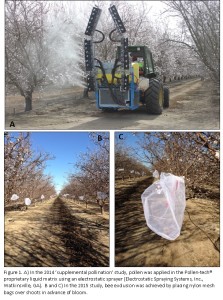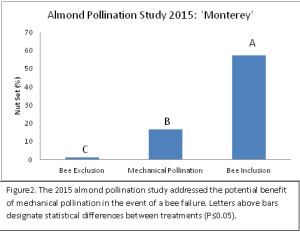Written by Elizabeth J. Fichtner, Farm Advisor, UCCE Tulare County and Katherine Wilson, Staff Research Associate, UCCE Tulare County
Each year during almond bloom, a fraction of growers try artificial pollination as either a supplement to bee pollination or an insurance policy against bee-inefficacy. Several factors may impact the availability and efficacy of bees as pollinators for California’s (CA) almond crop. Increasing almond acreage has increased the overall demand for hives while chronic honey bee health issues limit hive supply. Additionally, bee efficacy for pollination may be challenged by adverse weather conditions during bloom. In an effort to either supplement bee pollination or provide an insurance policy against inefficient bee-pollination, growers have utilized two different approaches to artificial pollination: 1) mechanical application of pollen to trees by blowers or airplanes, and 2) insertion of pollen dispensers (‘inserts’) into hives.
Conceptually, the application of pollen to trees by blowers relies on bee activity to redistribute pollen within the orchard; only a small amount of the blown pollen would be deposited directly on receptive stigmas. Several research studies, however, have demonstrated that techniques involving “blowing” pollen onto trees have no benefit as a supplement to bee pollination on fruit set or yield (ie. Schupp, 1997). A published 1966 almond research trial similarly demonstrates a lack of benefit of supplemental, mechanically-blown pollen on Nonpareil nut set and yield in a 2:1 block of Nonpareil and Mission (Thorp et al., 1967). Conversely, a study in 1978 demonstrated a value of mechanically-blown pollen on nut set (Thorp, 1978), but replication of the study in 1979 did not demonstrate any effect of artificial pollination (Thorp, et al. 1979). The orchard housing the 1978 and 1979 trials was chosen due to its unfavorable varietal combination (1:4:1, with 4 contiguous rows of Nonpareil) –a combination not utilized by the current CA almond industry.
The use of pollen inserts in hives, has been found to benefit nut set in an older orchard design containing two adjacent Nonpareil rows spanned by pollinizer rows (1:2:1) on either side; however, hive inserts have been found ineffective at increasing nut set in orchards using the modern-day configuration with single Nonpareil rows spanned by pollinizer rows (Dag, et al., 1998). The potential value of mechanical pollination in the event of a bee failure is largely unknown. To address the efficacy of mechanical pollination as either a supplement or replacement of bees, replicated field trials were conducted in the southern San Joaquin Valley (SSJV) in 2014 and 2015, respectively.
Timing of stigma receptivity in almond
To assess the potential value of mechanical pollination on nut set of almond, one should first consider the appropriate timing of pollen application with respect to stigma receptivity. Almonds differ from other Prunus species in that the embryo sac is not mature at anthesis (fully open flowers). Pollination and pollen tube growth in the style are necessary to stimulate embryo sac development; consequently, embryo sac maturation occurs around a week after anthesis (Pimienta and Polito, 1983).
Recent studies on ‘Nonpareil’ and ‘Padre’ demonstrate that flower stage affects pollen germination and germ tube elongation (Yi et al., 2006). Generally, pollen germination and germ tube elongation are highest at later stages of flower development, immediately prior to petal fall or at petal fall, but before the stigma has darkened in color. Young ‘Nonpareil’ flowers (petals unfurling/curved) do not support pollen germination. When pollination occurs early in flower development, successful fertilization may rely on pollen remaining viable until the stigma becomes receptive; this may take hours or days depending on the rate of bloom in a given orchard and season.
Mechanical pollination ‘event’ vs. bee pollination ‘process’
A second consideration on the potential value of mechanical pollination as a supplement or replacement of bees is the concept of probability of successful deposition of pollen on receptive stigmas. Bee pollination is a process spanning the entirety of bloom, thus allowing individual flowers, those opening at beginning of bloom and those opening at end of bloom, the opportunity for bee visits. Conversely, mechanical pollination is an event. Unless bees redistribute applied pollen, only flowers open at the time of the mechanical pollination (ie. ‘blowing’) event have the potential of receiving pollen. Flowers in the early phase of opening may not yet be receptive, but a fraction may still set a nut if environmental conditions favor pollen survival until the stigma becomes receptive. In short, mechanical pollination, in absence of bees, only has the potential to pollinate a fraction of the flowers open during the pollination event.
‘Random delivery’ vs. ‘directed delivery’ of pollen
A third consideration in mechanical vs. bee pollination is the delivery mechanism of pollen to the flower. In the absence of bees for pollen redistribution, mechanical pollination achieves a random deposition of pollen on the tree, whereas bee pollination is a more directed form of pollen delivery because the bees specifically visit flowers.
Applied research on mechanical pollination as a supplement to bee activity
In 2014 a replicated field trial was conducted in the SSJV to determine the potential benefit of mechanical pollination as a supplement to bee activity. The study included three cultivars, ‘Fritz’, ‘Nonpareil, ’and ‘Monterey’ (1:2:1), and treatments were applied in a randomized complete block design, with border rows surrounding treated rows to mitigate the potential impact of pollen drift. Rows ran north to south. Pollen, sourced from Wood Colony and Fritz varities, was applied twice to test rows, at 30-40% bloom and 50-60% bloom, and at three different experimental rates, 0, 23.5 and 70 g/acre. The flower buds were counted on flagged branches on 5 trees per test row (10 branches flagged per tree; 5 on the east and 5 on the west). Pollen was suspended in the Pollen-Tech® proprietary liquid matrix and applied using an electrostatic sprayer (Electrostatic Spraying Systems, Inc., Watkinsville, GA) (Figure 1A). Pollen germination rates consistently exceeded 85% prior to application. Final nut set was determined the first week of May and calculated as (number of nuts/number of flower buds) *100.
The sample size in our study allowed for detection of as little as 2.7% difference in nut set, as evidenced by differences in nut set detected on the east and west sides of ‘Fritz’ and ‘Monterey’ rows, with higher nut set on the west than on the east side of rows (Table 1).
Table 1. Percent nut set on east and west sides of Nonpareil, Monterey, and Fritz in May 2014.
| Variety | Nut Set East (%) | Nut Set West (%) | T ValueW |
| NonpareilX | 27.7 | 26.3 | NS |
| MontereyY | 21.2 | 23.9 | T ≤ 0.05 |
| FritzZ | 22.9 | 25.7 | T ≤ 0.01 |
W A paired t-test was used to compare average percent nut set on the east and west side of flagged trees. X Five flags were placed on the east and west side of randomly selected Nonpareil trees (N=45). A one-tailed, paired t-test was utilized to compare average nut set on east and west sides of trees. Y Five flags were placed on the east and west side of randomly selected Monterey trees (N=58). A one-tailed, paired t-test was utilized to compare average nut set on east and west sides of trees. Z Five flags were placed on the east and west side of randomly selected Fritz trees (N=53). A one-tailed, paired t-test was utilized to compare average nut set on east and west sides of trees.
Supplemental pollination treatments failed to significantly affect nut set or yield in the 2014 study. In support of this finding, our research team additionally found no correlation between distance from bee hive and nut set, thus suggesting that bee activity was not limited in the orchard. In summary, the 2014 study, conducted in a single orchard and in a single year, did not demonstrate a benefit of supplemental mechanical pollination in a bee-pollinated almond orchard system.
Applied research on mechanical pollination as an insurance policy in the event of a bee inefficacy
In 2015, we established a research trial to address whether mechanical pollination of almond may ensure the set of a harvestable crop in the event of a bee failure. The 2015 study focused on ‘Nonpareil’ and ‘Monterey,’ with treatments nested on 12 replicate trees of each variety. Three treatments were included in the study: 1) No mechanical or bee-pollination, 2) Mechanical pollination only, and 3) bee + mechanical pollination. All three treatments were represented on the east and west sides of test trees. Immediately prior to bloom, flower buds were counted on flagged branches and nylon mesh bags were placed over branches as bee-barriers (treatments 1 and 2) (Figure 1 B and C). Immediately prior to mechanical pollination, paper bags were placed over nylon mesh bags to prevent mechanically-applied pollen deposition on flowers (treatment 1). Mesh bags were removed from branches in treatment 2 immediately prior to spray rig movement down the test row; nylon bags were immediately replaced to prevent bee pollination. Pollen was applied at approximately 60% bloom using an electrostatic sprayer. Due to spray rig failure, full mechanical pollination was only achieved on the ‘Monterey’ test row; therefore, no results are reported for ‘Nonpareil.’
The results of the 2015 study suggest a benefit of mechanical pollination on nut set of ‘Monterey’ compared to the bee exclusion treatment (treatment 1) (Figure 2). Only 1.3% nut set was achieved in the bee exclusion treatment. Mechanical pollination alone resulted in 17% nut set. The bee-inclusion treatment, which included both bee pollination and any supplemental pollen deposited by mechanical pollination, resulted in 57% nut set, thus demonstrating the efficiency of bees in setting a crop.
Summary
The results presented indicate the potential value of mechanical pollination to set an almond crop in the event of bee inefficacy or unavailability. While mechanical pollination may set a small crop in the absence of bees, the implementation of the technology is largely an economic decision based on whether the potential yield benefit will outweigh the cost of mechanical pollen application. The bee-exclusion study will be repeated in 2016. The 2014 results do not suggest that mechanical pollination significantly supplements bee pollination, thereby corroborating the findings of others (ie. Thorp et al., 1967). It is important to note that environmental conditions vary between orchards and years, and the results presented in this article are limited the orchard conditions and parameters available and utilized during each study.
Select References and Literature Cited
1.Dag, A., Weinbaum, S., Thorp, R.W., Eisikowitch, D. 1998. Pollen dispensers (inserts) increasefruit set and yield in almonds under some commercial conditions. Journal of Apicultural Research. 39:117-123.
- Griggs, W.H., Iwakiri, B.T. 1964. Timing is critical for effective cross pollination of almond flowers. California Agriculture 18:6-7.
- Pimienta, E. Polito, V.S. 1983. Embryosac development in almond [Prunus dulcis (Mill) Webb, D.A.]. Annals of botany. 51:469-479.
- Schupp, J.R., Koller, S.I., Hosmer, W.D. 1997. Testing a power duster for pollination of ‘Mcintosh’ apples. HortScience. 32: 742.
- Thorp, R.W., Stanger, W., Aldrich, T. 1967. Effects of artificial pollination on yield of Nonpareil almond trees. California Agriculture 21 (9): 14-15.
- Thorp, R.W. 1978. Tree Research: Pollination (Project No. 78-T3). Annual report on research sponsored by the Almond Board of California. http://www.almonds.com/growers/resources/research-database.
- Thorp, R.W., Briggs, D.L., Parisian, T., Sugden, E., Brown, J. 1979. Tree Research: Pollination (Project No. 79-04). Annual report on research sponsored by the Almond Board of California. http://www.almonds.com/growers/resources/research-database.
- Yi, W., Law, S.E., McCoy, D., Wetzstein, H.Y. 2006. Stigma development and receptivity in almond (Prunus dulcis). Annals of Botany. 97:57-63.
Acknowledgements: We thank Dr. Robbin Thorp and M. Kim Fondrk for their thoughtful review and comments. We appreciate the financial support and cooperation of Pollen Tech®, as well as the cooperation of South Valley Farms and Valley Orchard Management, LLC. Additionally, we are grateful for the field assistance of Walter Martinez and Brent Dougherty, UCCE Tulare County.


